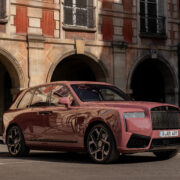Sometimes, Progress Comes With A Rear-View Mirror.

With nearly a decade of dedicated experience, Alexandra Popescu-Zorica is…
On a quiet Saturday morning in Berlin, an old Porsche 911 cruises past a row of minimalist electric charging stations. Its distinct silhouette slices through the stillness with effortless style. Children turn their heads, not because it’s loud—this one has been retrofitted with an electric engine—but because it’s different. It tells a story. A story of craftsmanship, of eras past, of a time when driving meant something more than getting from A to B.
This isn’t just a car—it’s a symbol. And it’s not alone.
In cities across the globe, we’re witnessing a curious mix of old and new: where vintage machines are brought back to life with modern technology, and cities are being redesigned not for cars, but for people.
Reimagining Cities for People
For over a century, cities have been designed around the automobile. Wide boulevards, parking lots, and multi-lane roads carved through communities in the name of progress. But that story is changing.
Today, from Amsterdam to Seoul, we’re seeing cities reclaim space. Sidewalks are being widened. Bike lanes are growing. Urban highways are being dismantled to make way for green corridors and outdoor cafes. In Paris, entire districts are turning into “15-minute neighborhoods,” where everything you need is within walking distance. In Barcelona, superblocks are replacing intersections with playgrounds and community gardens.
This shift isn’t only about reducing traffic. It’s about improving air quality, reducing noise, boosting mental health, and building stronger local communities. It’s a recognition that a car-dominated city might be efficient—but it’s rarely joyful.
The Vintage Revival: Sentiment, Sustainability, and Self-Expression
In parallel, a different movement is unfolding—one that looks backward to move forward. A growing number of people, particularly younger generations, are opting out of the race for the latest SUV or tech-laden EV. Instead, they’re buying older vehicles—iconic models from the 60s, 70s, and 80s—and restoring them.
This isn’t just about style, although there’s plenty of that. It’s about rebellion. Against mass production. Against disposable culture. Against sameness.
Some retrofit these classics with electric drivetrains, combining elegance with eco-consciousness. Others leave them as they are, a rolling homage to mechanical authenticity. In both cases, it’s an act of preservation—and of protest. A reminder that mobility can be personal, poetic, even slow.
Looking Ahead: The City as a Living Organism
What do these two movements—urban redesign and vintage revival—have in common?
Both are responses to an era of excess. Both are trying to make mobility meaningful again.
We’re entering a new chapter—one where the question is no longer just “how fast can we get there?” but “what kind of life do we want along the way?” In this future, mobility is not defined by horsepower or speed, but by freedom of choice. A walk through a safe, green street. A bike ride to a nearby market. A restored vintage car humming quietly through a weekend drive, not as necessity, but as pleasure.
The road ahead isn’t just about innovation. It’s about imagination. About cities that breathe. About streets that belong to people again. And about remembering that, sometimes, progress comes with a rear-view mirror.
What's Your Reaction?
With nearly a decade of dedicated experience, Alexandra Popescu-Zorica is a seasoned consultant, mentor, and the dynamic host of a compelling podcast - House of Innovation, that delves into the challenges but also multiple benefits of fostering innovation and entrepreneurship in large organizations and societies. Alexandra's professional journey is marked by her hands-on expertise in building entrepreneurial teams and cultivating innovation capabilities within expansive corporate settings. Not only does Alexandra show tremendous passion for corporate innovation, but she is also deeply committed to nurturing the growth of startups. Having collaborated with over 100 startups, Alexandra has left a mark in transforming innovative ideas into thriving businesses, through her collaboration with startup accelerators and incubators such as Junior Achievement. In 2023, Alexandra's contributions to the field of Innovation were officially recognized by the esteemed Academy of Economic Studies. She was bestowed with a prestigious award in Innovation Management, a testament to her achievements and influence in shaping the future of business and entrepreneurship. Her hands-on experience is complemented by a fervent passion for continuous learning. Testimony to that commitment are the official recognitions and certifications in Design Thinking, Effectuation, Behavioral Science from the University of Toronto, as well as Managing Business Growth from Oxford. As a thought leader, mentor, and consultant, Alexandra Popescu-Zorica continues to inspire and guide individuals and organizations alike on their path to success in the dynamic worlds of corporate innovation and entrepreneurship. Her upcoming column in Gazetta promises to be a captivating exploration of the latest trends, strategies, and stories that define the ever-evolving landscape of business innovation. You can follow Alexandra on LI.



